Ventilation control panel: device, purpose + how to assemble correctly
Industrial buildings, public institutions and residential buildings are equipped with complex air conditioning and ventilation networks. To organize the operation of a system that combines many technical devices, a ventilation control panel - SHCHUV - is used.
We will tell you how to assemble a shield that allows you to control the ventilation system and set the optimal mode for work or rest. The article we presented shows the components and describes the features of their connection. Taking our recommendations into account will help you competently automate the startup and shutdown of equipment.
The content of the article:
Purpose of the ventilation control panel
If you need to turn on or configure a household split system or appliances supply ventilation, fixed in the hole of the ventilation duct, then no control units are required - each device is adjusted manually or from the remote control.
But if the length of the networks is large, and the devices are installed in inaccessible places: in shafts, on the roof or attic, in specially designed niches inside the walls, then it becomes necessary to install a remote control unit.

Modern control panels are panels with indicator control devices or metal cabinets that are installed on the floor or suspended from the wall.To protect the internal contents, there are hinged doors that can be locked. In addition to the abbreviation SHUV, you can also find SHUV (cabinet).
Main functions of the SHCHUV:
- control over equipment included in ventilation and air conditioning systems;
- protection of units from overheating, incorrect installation and connection, short circuit;
- adjustment of the most important equipment parameters, such as productivity or power;
- programming the operation of the entire system or individual units for a given time period - day, week, month;
- providing an indication that facilitates monitoring and adjustment;
- maintaining a certain temperature in various rooms, the ability to quickly change its parameters;
- control over the internal walls of air ducts and the degree of filter contamination;
- preventing failures in the operation of seasonally dependent equipment, for example, water heaters, which can freeze at too low temperatures.
Installing an electrical panel at an enterprise or in a residential building allows maintenance personnel to monitor the operation of equipment from one place and quickly respond to breakdowns and shutdowns of individual devices. Devices that control fire extinguishing and partial heating devices can also be located in the same cabinet.
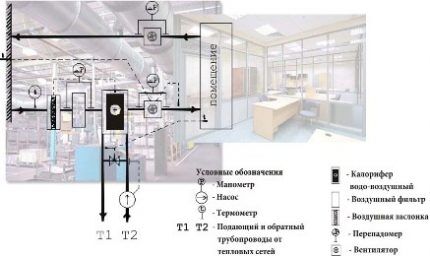
If an emergency occurs, for example, a fire in one of the rooms, the ventilation equipment is stopped automatically or manually - from the control panel.
Features of the SHCHUV device
Installation and configuration of control panels is carried out according to the rules and regulations dictated by government documents, such as GOST R 51321.1. Pump cabinets and electricians, panels for ventilation and air conditioning systems are installed in corridors, utility rooms or in specially designated rooms - switchboards.
If the building has the capabilities, then all control units, including ventilation and fire protection, are installed in control rooms.
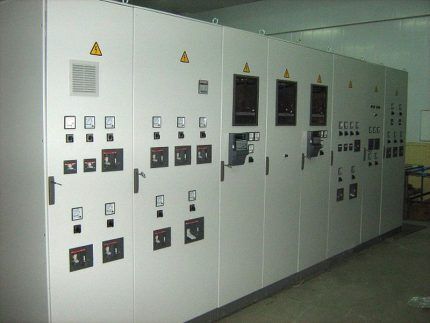
Manufacturers of electrical equipment offer a variety of configurations that vary in size, functionality, degree of protection and level of programming. The simplest modifications are intended for servicing private residential real estate, while complex modifications are intended for enterprises and public buildings.
Requirements for the configuration of control panels
When choosing a SHUV, they are guided by the size of the working area, the ability to install the necessary devices, ergonomics and safety. The last point applies both to the installers themselves, who regularly service the networks, and to people who may be nearby.
The main requirements for SHUV and SHUV are as follows:
- the panel must accommodate all control devices for the ventilation and air conditioning system;
- important components must be equipped with an indication, light, digital or connected to a PC;
- devices responsible for the most important equipment must have dual control - automatic and manual.
All devices are neatly placed on the same plane.The package should be as simple and easy to understand as possible. If the ventilation panel is assembled according to all the rules, then, if necessary, even a person ignorant of electricity will be able to turn off emergency devices.

The content and functionality of the shields may vary. For example, some systems require a frequency converter, while others do without it. The most convenient for use are cabinets and panels with automation and remote controls.
Work Item Overview
Structurally, the SHUV is a rectangular plastic or metal case with the required protection class IP 45. If operating conditions are associated with an increased risk, then the protection class is higher.
Inside the case there are devices such as a power supply, controller, and converters. Several circuit breakers are responsible for individual devices: air heaters, recuperators, fans, cooling units, etc.
A mandatory element is a manual control panel. An alarm unit is also required, which is triggered in an emergency and produces warnings with light or sound signals.

Control elements also include sensors. These are a kind of receptors that collect various information about the state of the system and its environment.
They measure the temperature of the air and the devices themselves, the degree of concentration of gases or contamination of system elements, measure the speed of air movement, etc. The data obtained is sent to automatic regulators, and the operation of the system elements is adjusted.
Based on their functions, sensors are divided into the following types:
- temperature;
- humidity;
- speed;
- pressure, etc.
Temperatures can be either digital or analogue. A signal about a sharp increase or decrease in indoor temperature may cause the system to switch to another mode.
Humidity sensors operate on the same principle. How do air masses move inside? ventilation ducts can be found out thanks to speed and pressure sensors. Based on their installation location, sensors are divided into internal and external. The first ones take data indoors, the second ones, which are also called atmospheric or street data, take data from outside buildings.
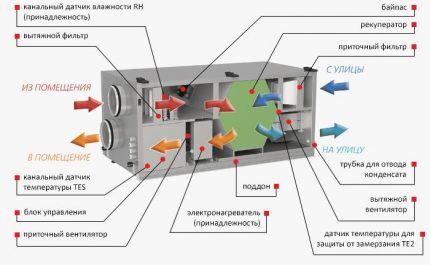
Some sensors are fixed on the surface of parts that need to be monitored. They take parameters of the devices themselves, for example, winding temperature, rotation speed, etc.
The installation of sensors requires careful selection. On the one hand, the more information, the more accurately the system operates, but on the other hand, the operation and maintenance of the network becomes costly in terms of energy consumption.
Controllers work in conjunction with sensors. These are the devices that receive information and process it automatically.They can be called intermediaries, since the signal is then transmitted to actuators: air flow switches, fans, refrigeration units, heaters.
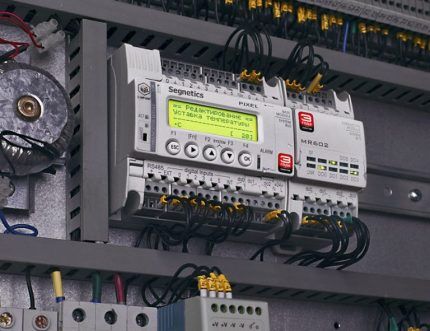
Particularly popular are universal type controllers, which are capable of simultaneously processing information coming from various systems: ventilation, heating, etc.
Recommendations for assembling SHUV
Installation and testing of control panels should be carried out by specialists with appropriate qualifications; independently installing and connecting elements inside a switchboard or cabinet is not only not recommended, but also prohibited.
The housings are not made by hand, but purchased ready-made or ordered taking into account the specifics of the ventilation system. A set of devices is supplied with the case: switches, controllers, power supplies, switches, protection elements and wires.
It often happens that the set of instruments and parts is not fully equipped - there are not enough wires or circuit breakers. When selecting spare parts, it is necessary to maintain compliance with the technical characteristics (for example, the cross-section of wires or the current strength of the machine).
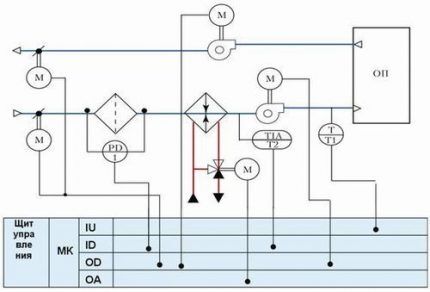
Before ordering, you must make a list of all devices that are included in the ventilation system, as well as express your wishes regarding switching operating modes, the type of controller, and the presence of certain sensors.In some control panels, relays are installed instead of controllers.
An example of a ShchUV can be a sample with the following technical characteristics:
- nom. frequency – 50 Hz;
- voltage – 380 V;
- voltage of the connected fan – 220 V;
- engine power – 22 kW;
- protection level – IP65;
- dimensions – 400x800x180 mm;
- service life – 10 years.
Ready-made models are marked with symbols that contain information about the modification and its standard size, degree of protection, type of climatic modification, technical specifications or GOST number. In the latter case, manufacturers are guided by GOST 14254 and GOST 15150.
Benefits of professional installation
According to the rules, installation and maintenance ventilation systems, as well as SHUV should be handled by specialists with an engineering education. They bear full responsibility for incorrect selection, installation, connection of devices, as well as for maintaining technical devices in improper or unsafe condition.
To correctly determine the contents of a panel or cabinet, installers do a full monitoring of the ventilation network.
Then you need to do the following:
- analyze the load;
- choose the optimal scheme;
- determine the operating modes of devices in order to increase efficiency;
- select equipment.
The assembly itself takes a little time: all the devices are mounted one by one in several rows, the wires are carefully connected to the terminal blocks and laid along the lines in organized bundles, then taken out.
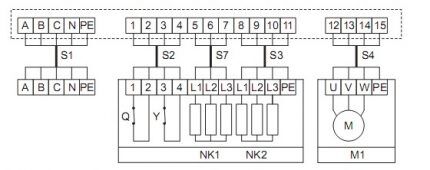
Professional installers have experience installing and operating control panels, so they are unlikely to make a mistake with the choice of model and the nuances of connecting devices. In addition, they are well versed in circuits. apartment ventilation systems and country houses and can quickly determine if there is an error in the drawing.
If you don’t figure it out in time and connect the devices according to an illiterate diagram - and this also happens - you can create an emergency situation.
The sale and distribution of panels and cabinets is carried out by many companies that produce or sell ventilation, refrigeration and heating equipment. For example, in Moscow this can be done in the companies “Ruklimat”, “Roven”, “AV-Avtomatika”, “Galvent”, etc.
Conclusions and useful video on the topic
What the SHUV looks like when assembled, what is included in the “filling”, how the devices are mounted and the wires are connected, can be seen in the videos below.
Step-by-step assembly and installation options:
Video review - sample assembly of SHUV with heater:
Automation of a ventilation or any other system is a responsible and expensive process. If the equipment is selected or assembled incorrectly, an accident may occur resulting in people being injured, for example, at a chemical plant.
At a minimum, equipment, also expensive, will fail. For these reasons, the installation of control units from the initial design stage to the end should be carried out exclusively by specialists.
Please write comments in the block below. Share information that may be useful to site visitors. Ask questions, tell us about how you installed the ventilation system control panel with your own hands, and post photos related to the topic of the article.




I don’t think anyone will need a panel to control the ventilation system at home; the automation for connecting it is usually installed in the common panel of the house/apartment. But for enterprises with production shops, service stations, confectionery shops, laundries, especially for safety engineers, the information is probably very useful.
Good afternoon, Davidskent.
Household climate systems are controlled by gadgets called “Thermostat”. In other words, there is no need for the usual sensors.
Honeywell recently announced the launch of the Prestige IAQ thermostat, which is compact. The dimensions are not indicated, but I have attached a photo of the moment of adjustment, allowing you to evaluate them. Previous models, the manufacturer writes, were twice as large.
The thermostat monitors many parameters of the room climate, initiating the operation of ventilation, air conditioning, and heating. The touchscreen screen does not exclude remote configuration of the gadget - it can be controlled from anywhere in the world, the manufacturer says. By the way, he controls the home climate system via wi-fi. Resource savings, testing has shown, reach 30%.
Why is there no information or diagram on the boards where you can see what and how this or that machine turns on or off.Where can I see if there is regulatory documentation that states whether such information should be on the boards or not?
I saw in electrical panels that all the information is there and is located inside the panel - mainly on the inner surface of the door. And everything is clear: what fuse, circuit breaker, wires go where, what is turned off, etc.
Are there really different requirements for ventilation control panels and electrical panels? Please explain to an amateur whether there is a documentary explanation of whether there should be information or a diagram on the boards or not?
Good afternoon, Alexander.
Ventilation control panels are functionally different from electrical switchboards. The purpose of the latter is the distribution of electricity into groups, which can be visually described graphically. The purpose of the control unit is to control many interdependent elements of the ventilation system. To clearly explain the complexity of the operation of the control unit, I have attached its functional diagram.
Operation of the ventilation system requires the participation of many specialists. For operating personnel, a mnemonic diagram is enough - it is demonstrated in the photo in the section “Features of the SHCHV device.” The electrical part of the device is occupied by electrical personnel - they are provided with another circuit. Automation is carried out by third-party specialists using their own schemes.
The complete operating diagram of the control unit is given in the passport.
Good afternoon. Question from an electrical designer. In what cases is it necessary to install a control unit? If there are only three exhaust fans in a building (dormitory) (2 in the showers and 1 in the electrical room), can they be turned on using the light switch (i.e. the fan and light turn on together). And is it possible to power the fans from the distribution panel, where the sockets are also powered?